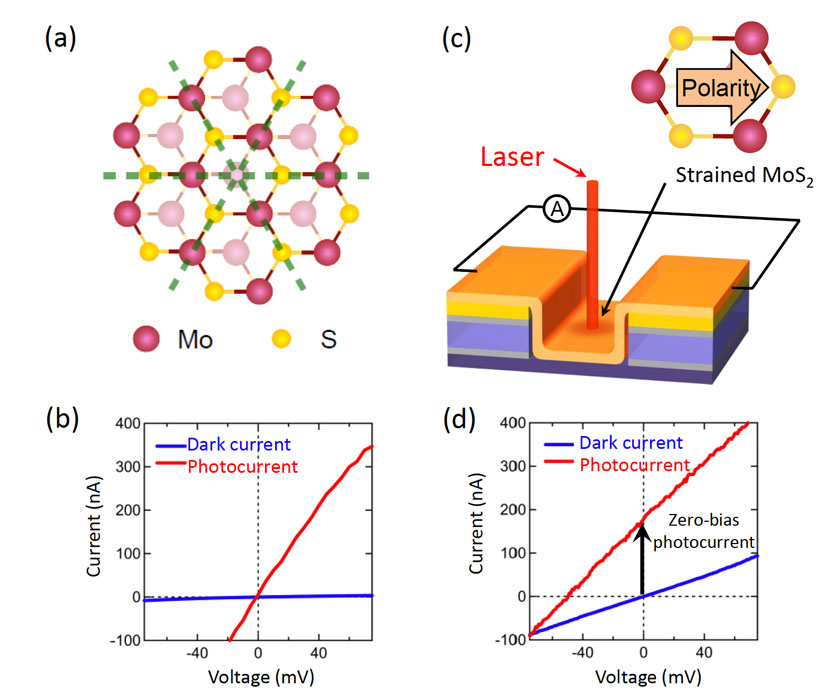Enhanced Bulk Photovoltaic Effect in Strained 3R-MoS2
Ideue Group
Bulk photovoltaic effect, which indicates the generation of spontaneous photocurrent in uniform materials instead of conventional p-n junctions, is attracting considerable interest due to its microscopic origins related to the electronic band topology or geometry as well as its potential to achieve a high solar energy conversion efficiency. So far, bulk photovoltaic effect has been reported in a variety of noncentrosymmetric quantum materials and several strategies to enhance the photocurrent magnitude are also developed. Among them, strain application is a simple method for controlling the crystal structures or electronic states and thus an effective way for realizing the enhanced photovoltaic signals.
In this work, we studied the effect of uniaxial strain on the bulk photovoltaic effect in van der Waals layered semiconductor 3R-MoS2. Without strain, 3R-MoS2 has a noncentrosymmetric trigonal crystal structure (Fig.1 (a)). Although it exhibits the photoconductivity, which indicates the enhancement of conductivity under the illumination of light, zero-bias photocurrent is negligibly small (Fig. 1 (b)). By transferring the exfoliated flake of 3R-MoS2 on a pre-patterned substrate consisting of two parallel steps and pushing it so that flake stretches and gets in contact with the bottom substrate part, we applied the uniaxial strain on 3R-MoS2 (Fig. 1 (c)). In strained samples, symmetry of the crystal is reduced and electronic polarization appears (inset of Fig. 1 (c)). We found that zero-bias photocurrent is largely enhanced in such strained samples (Fig. 1 (d)). We confirmed that photocurrent appears when the light is illuminated at the center of the device away from the electrodes and flows only along the direction parallel to the electronic polarization. It is also observed that the magnitude of the zero-bias photocurrent increases in a nonlinear manner with the value of uniaxial strain. These results implies that the observed zero-bias photocurrent is the intrinsic bulk photovoltaic effect and the emergence of the electronic polarization is essential to enhance the bulk photovoltaic effect.
We further studied the detailed light power dependence and photon energy dependence of the bulk photovoltaic effect. The light power dependence of the photocurrent shows the characteristic crossover, evolving from a linear relation to a nonlinear manner while increasing the light intensity. The photon energy dependence of the zero-bias photocurrent exhibits the non-monotonic behavior differently from the absorption spectrum. These behaviors can be well explained by the shift current, which is one of the origins of bulk photovoltaic effect related to the geometrical properties (Berry connection or shift vector) of the wave function and arises from the shift of the wave packet under the optical transition.
In summary, we have demonstrated the gigantic enhancement of bulk photovoltaic effect by uniaxial strain in van der Waals layered semiconductor 3R-MoS2. This work clarifies the important role of symmetry reduction and the induced electric polarization for the large photocurrent generation, enriching our knowledge concerning the microscopic mechanism of bulk photovoltaic effect in non-centrosymmetric systems. Present results also indicate that strain application is a powerful method to control the symmetries, geometric properties of the electronic wave function, and resultant physical properties of flexible layered materials.
References
- [1] Y. Dong, M. Yang, M. Yoshii, S. Matsuoka, S. Kitamura, T. Haswgawa, N. Ogawa, T. Morimoto, T. Ideue, and Y. Iwasa, Nat. Nanotechnol. 18, 36 (2023).

